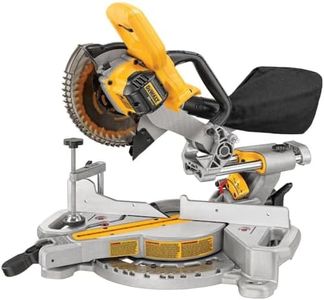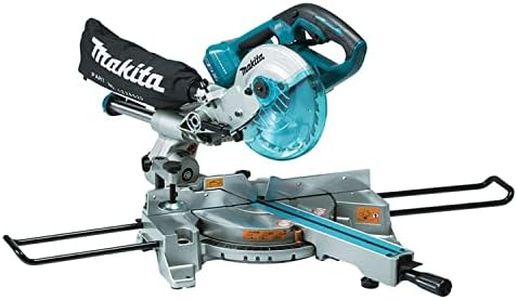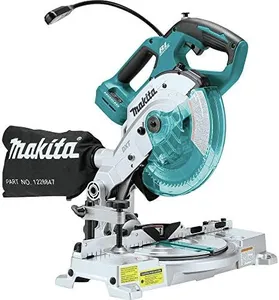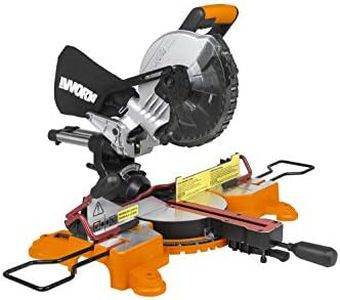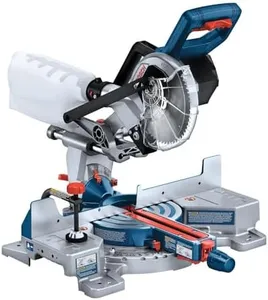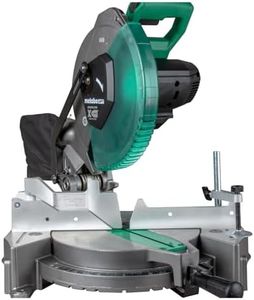We Use CookiesWe use cookies to enhance the security, performance,
functionality and for analytical and promotional activities. By continuing to browse this site you
are agreeing to our privacy policy
10 Best Cordless Miter Saw
From leading brands and best sellers available on the web.Buying Guide for the Best Cordless Miter Saw
Choosing the right cordless miter saw can make cutting wood and other materials much easier and safer, especially if you value flexibility and portability on the job site or around your home. Because they are battery powered, cordless miter saws offer you freedom from power cords and outlets, but it’s important to understand which features matter most so you get a tool that fits your needs. Before you shop, think about the materials you’ll be cutting, where you’ll use the saw, and how often you’ll use it.Blade SizeBlade size on a cordless miter saw determines how thick and wide a piece of material you can cut in a single pass. Common blade sizes are 7-1/4, 8-1/2, and 10 inches, with larger blades allowing you to cut wider pieces. Smaller blades are lighter and more portable but limited in what they can handle, making them good for trim, molding, and lighter work. Larger blades suit you if you frequently cut bigger boards or framing lumber. Choose a blade size based on the size of your typical projects and the balance you want between portability and cutting capacity.
Cutting CapacityCutting capacity refers to the maximum height and width of material the saw can cut at 90 degrees (straight) and when angled for miter or bevel cuts. Saws with higher cutting capacities can handle larger crown molding, wider boards, and thicker lumber. Entry-level saws can generally cut 2x4s or basic trim, while higher-capacity models can accommodate 2x8s or even larger. Consider the largest material you want to cut—if you’re mainly doing small trim, you can go smaller, but if you work with wide boards or moldings, look for greater capacity.
Bevel RangeBevel range describes the angles to which the saw’s blade can tilt for bevel cuts, beyond straight cuts. Some saws offer only a single bevel (tilting to one side), while others dual bevel (tilting both left and right), making it easier and faster to make complex cuts without flipping your material over. If you’re planning projects like trim work or furniture where angled cuts are common, a wider and dual-sided bevel range will make your work more flexible and precise.
Battery Voltage and RuntimeBattery voltage indicates the power available, and runtime means how long you can use the saw on a single charge. Higher voltage usually gives more cutting power for tough materials, but can make the saw heavier. Saws with efficient motors and larger-capacity batteries cut for longer before needing a recharge. If you anticipate long sessions or thick materials, seek higher voltage and longer runtime; for occasional, light-duty use, lower values can be sufficient and keep the tool lighter.
Sliding RailsSliding rails allow the saw’s head to move forward and backward, giving you the ability to cut wider boards than a non-sliding model with the same blade size. If you mostly cut narrow pieces, a non-sliding saw is lighter and typically more accurate. But if you expect to deal with wide shelving or baseboards, the sliding feature greatly increases what you can accomplish with a compact tool.
Dust CollectionDust collection refers to the saw’s ability to capture the debris produced during cutting, helping keep your workspace cleaner and safer. Some saws have integrated dust bags or ports that can connect to shop vacuums. Better dust collection is helpful if you work indoors, in small spaces, or just want less mess to clean up. If this is important for you, check how the saw captures and contains dust, and whether it’s compatible with your current vacuum systems.
Weight and PortabilityThe overall weight of the saw affects how easily you can move it between locations or job sites, which is especially important in cordless models. Lightweight models are easier to carry and store, but heavier saws may offer more cutting power or stability during use. Choose a weight that matches how often you need to move the saw—if it will live in one workshop, weight matters less than if you’re frequently on the go.


